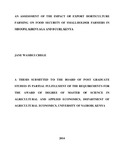| dc.description.abstract | In attempting to achieve household food security for smallholder farmers, the question of having food security in the pocket, which is the use money from cash crop to purchase food or food security through food self-sufficiency by consumption of one’s own produce, elicits strong debate. Synergies and tradeoffs exist between cash cropping, food cropping and food security. Available evidence on the impact of cash cropping on food security shows mixed results. Different potential negative and positive impacts can be identified which vary with choice of cash crops and the situation in which they are being grown and marketed. Following these mixed results from literature, the relationship between cash cropping and food security seems non-linear and unpredictable and it is not possible to tell what the effect of a particular cash crop on food security is, unless an empirical analysis is carried out.
Production of horticultural products for export is a major cash cropping practice in Kenya which is ranked third in terms of foreign exchange earnings after tourism and tea. It is practiced in different regions in the country but three districts (Kirinyaga, Mbooni and Buuri) were used in this study for comparative reasons.
The study sought to assess the food security situation in the study areas, estimate the factors influencing the food security situation and finally assess the impact of export horticulture on food security situation. Per capita calorie intake (7-day recall) and Household Dietary Diversity Index (HDDI) methods were used to measure food security. Per capita calorie intake assessed the adequacy of food intake while the HDDI assessed the quality of food intake. Ordinary Least Squares (OLS) and Poisson regressions were estimated to assess the factors affecting food security. To assess impact of export horticultural farming on food security, a propensity score matching method was employed on per capita calorie intake. Per capita calorie intake results indicated that on average smallholder farmers in Mbooni were food insecure while those of
x
Kirinyaga and Buuri were food secure. However, there was no significant difference in the diet quality in these districts as indicated by the HDDI. Export horticulture farming had a positive effect on per capita calorie intake in Kirinyaga district but a negative effect in Mbooni district. The effect in Buuri district was not statistically significant.
Household size was found to negatively affect per capita calorie intake across all the districts. It was also found to affect HDDI negatively in Buuri and Kirinyaga but had a positive influence in Mbooni. Household head education, water source, wealth and the household head years of farming experience were positively influencing per capita calorie intake in Mbooni. In Kirinyaga, total acres, the gender of the household head and income category were found to positively influence per capita calorie intake. In Buuri, the proportion of the time when the household head is able to get employment in or out of his or her farm was found to positively influence the per capita calorie intake and so was group membership, source of water and the total acres in a household. Growing export horticulture was found not to have any significant effect on diet quality in Buuri and Mbooni but had a positive effect in Kirinyaga.
Policies aimed at encouraging smallholder farmers to participate in export horticulture farming should be promoted in Kirinyaga. However, the study recommends further analysis on the production and marketing conditions of export horticulture in Mbooni. An in depth livelihood analysis and gender dimensions of income use is also called for. | en_US |

